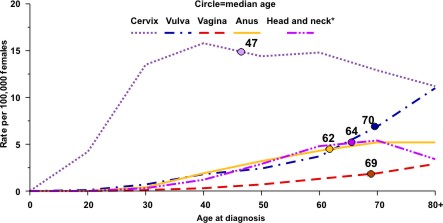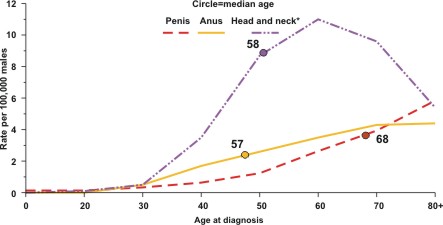|
|
||||||||||||||||
|
|
|
|
|
|||||||||||||
|
|
Control and Prevention Division of Cancer Prevention and Control 4770 Buford Hwy, NE MS K-64 Atlanta, GA 30341-3717 Call: 1 (800) CDC-INFO TTY: 1 (888) 232-6348 FAX: (770) 488-4760 E-mail: cdcinfo@cdc.gov Submit a Question Online |
|
|
|
Age at DiagnosisCervical cancer is usually diagnosed at younger ages than other HPV-associated cancers. HPV-associated anal and head and neck cancers are generally diagnosed at slightly younger ages in men than in women. The median age at diagnosis (the age at which half of cancer patients were older and half were younger), is—
Rates of HPV-associated cancers and median age at diagnosis among women in the United States, 1998–2003 
Rates of HPV-associated cancers and median age at diagnosis among men in the United States, 1998–2003 
Note: Not all cancers of the head and neck were included. A smaller group of cancers in specific areas often associated with HPV were included. All cancers were limited to cell types most likely to be HPV-associated. This chart was adapted from Watson M, Saraiya M, Ahmed F, Cardinez CJ, Reichman ME, Weir HK, Richards TB. Using population-based cancer registry data to assess the burden of human papillomavirus-associated cancers in the United States: Overview of methods. Cancer 2008;113(S10):2841–2854.
Page last reviewed: November 5, 2008
Page last updated: November 5, 2008 Content source: Division of Cancer Prevention and Control, National Center for Chronic Disease Prevention and Health Promotion |
|
||||||||||||
|